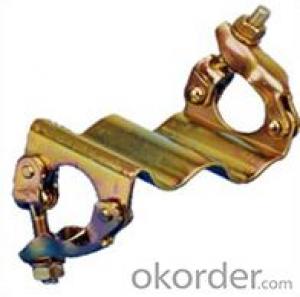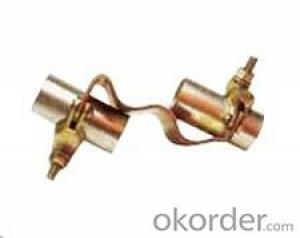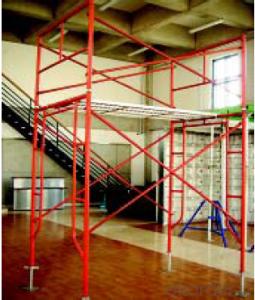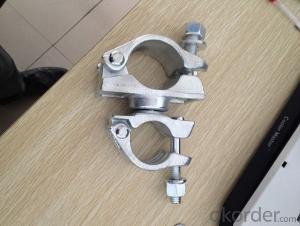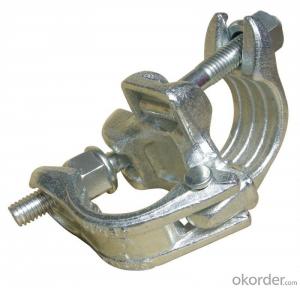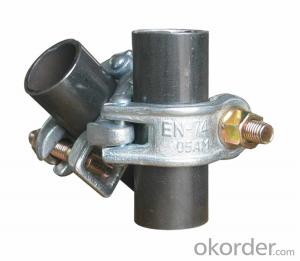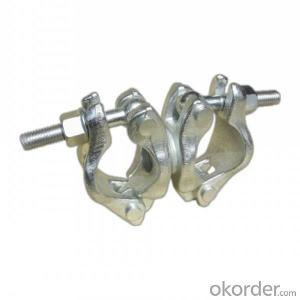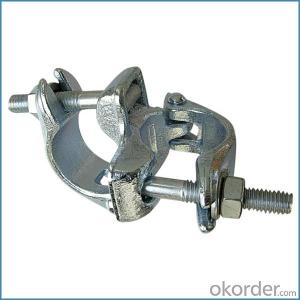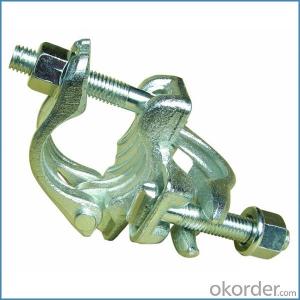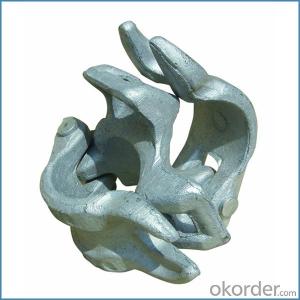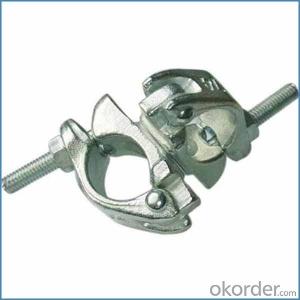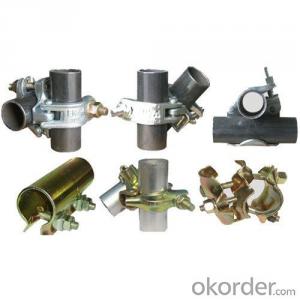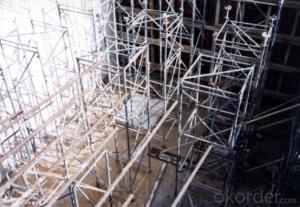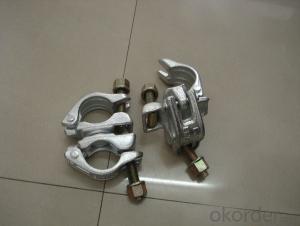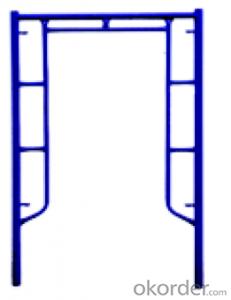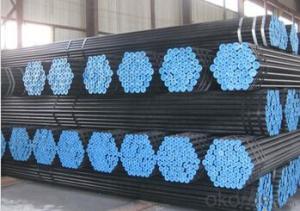Scaffolding Double Clamp british German Forged Type
- Loading Port:
- Tianjin
- Payment Terms:
- TT OR LC
- Min Order Qty:
- 1000 kg
- Supply Capability:
- 100000 kg/month
OKorder Service Pledge
OKorder Financial Service
You Might Also Like
Scaffolding Double Clamp british German Forged Type
Description
1.The scaffolding coupler is always used to connect the steel pipe as scaffolding system.
2.The often used coupler is swivel coupler and righ angle coupler .
3.We can provide types of scaffolding coupler according to your requirement.
4.Couoler can fix the 48.3mm scaffolding steel pipe tightly and make the whole scaffolding system more steadily.
Feature
(1)Excellent Anti-Breaking—Cold Pressed Steel
(2)Outstanding Resistance Deformation
(3)Strong Anti-Dropping Ability
Photo
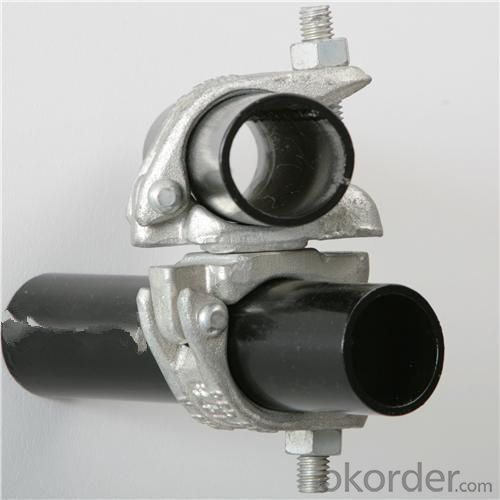
Parameter
| Material | Q235,345steel |
| Size | 48.3mm*48.3mm |
| Surface finish | Galvanized |
| Weight | 1.1kg around |
| Standard | BS1139,EN74 |
| Package | 25pcs/bag,steel pallet |
| Manufacture | As per customer requirement |
| Market | Africa, South America, the Middle East and Asia |
FAQ
Q: Are you a factory or trading company?
We are a state-owned corporation in China,dealing with various kinds of building materials.We have our holding subsidiaries.
Q: Where is your factory located? How can I visit there?
Our factory is located all around China.
Q: Can I get some samples?
Sample is free, customer only pay freight for the first time.
Q: Delivery?
10-30days. (5-15 containers)
Any question,feel free to contact us.
- Q: How do steel tube couplers attach to scaffolding tubes?
- Steel tube couplers attach to scaffolding tubes by being tightened onto the tubes using a bolt and nut mechanism. The coupler has two halves, each with a threaded hole. These halves are placed around the tubes, and the bolt is inserted through the holes and tightened with a nut, securely holding the tubes together.
- Q: Can steel tube couplers be used in scaffolding systems that need to withstand extreme weather conditions?
- Yes, steel tube couplers can be used in scaffolding systems that need to withstand extreme weather conditions. Steel is a durable and strong material that can withstand harsh weather conditions such as high winds, heavy rain, and extreme temperatures. Steel tube couplers are designed to provide a secure connection between scaffolding tubes, ensuring stability and safety in challenging environments. Additionally, steel is resistant to corrosion, which is crucial when scaffolding systems are exposed to moisture and harsh elements over an extended period. Therefore, using steel tube couplers in scaffolding systems is a reliable choice for withstanding extreme weather conditions.
- Q: What are the common industry standards for steel tube couplers in scaffolding?
- The British Standards Institution (BSI) typically defines the common industry standards for steel tube couplers in scaffolding. The commonly followed BSI standards are BS1139 and EN 74. BS1139 serves as the British standard for tubes, couplers, and scaffolds. It outlines the requirements for steel tubes, fittings, and couplers used in constructing scaffolding systems. This standard covers dimensions, material properties, and performance requirements for steel tube couplers. It also offers guidance on the design, construction, and use of scaffolding systems. EN 74, on the other hand, acts as the European standard for couplers, fittings, and accessories employed in assembling scaffolding. This standard guarantees compatibility and interchangeability of components across various scaffolding systems. EN 74 lays out the dimensions, mechanical properties, and testing procedures for steel tube couplers to ensure their strength, durability, and safety. Apart from these standards, there are also different national and international codes and regulations that govern the use of steel tube couplers in scaffolding, depending on specific countries or regions. These codes may incorporate additional requirements and guidelines to ensure the safety and reliability of scaffolding systems. Manufacturers, suppliers, and users of steel tube couplers in scaffolding must adhere to these industry standards to guarantee the quality, compatibility, and safety of their scaffolding systems. Compliance with these standards aids in minimizing accident risks, maintaining structural integrity, and upholding the overall performance and reliability of scaffolding installations.
- Q: What are the common uses for steel tube couplers in scaffolding?
- Steel tube couplers are commonly used in scaffolding for a variety of purposes. One of the most common uses for steel tube couplers in scaffolding is to join together two or more steel tubes to create a secure and stable structure. These couplers are designed to be strong and durable, ensuring that the scaffolding remains stable and safe for workers to use. Steel tube couplers are also often used to connect horizontal and vertical steel tubes in scaffolding systems. This allows for the creation of a rigid and stable structure, which is essential for ensuring the safety of workers who are using the scaffolding. Another common use for steel tube couplers in scaffolding is to create different configurations and shapes. By using different types of couplers, such as swivel couplers or right-angle couplers, scaffolding can be constructed in various shapes and sizes to meet the specific needs of a project. In addition, steel tube couplers are used to secure accessories, such as toe boards or guardrails, to the scaffolding structure. This helps to enhance the safety of workers by providing additional protection and preventing falls from the scaffolding platform. Overall, steel tube couplers are essential components in scaffolding systems, as they allow for the secure joining of steel tubes, the creation of different configurations, and the attachment of safety accessories. These couplers play a crucial role in ensuring the stability, strength, and safety of scaffolding structures.
- Q: Can steel tube couplers be used in different sizes of scaffolding tubes?
- Yes, steel tube couplers can be used in different sizes of scaffolding tubes. These couplers are designed to securely connect and hold together scaffolding tubes of various sizes, providing a strong and stable structure for construction purposes.
- Q: "Construction of the target safety technical specifications" JGJ162-.1.9 Article 3 of the first sentence: along the vertical and horizontal horizontal direction should be vertical and horizontal on the program settings. JGJ130-.3.2 The third sentence: Horizontal sweeping pole should be fixed with a right angle fastener close to the vertical sweeping pole on the bottom of the pole. (On the vertical and horizontal) I personally in accordance with the (longitudinal performance of the spy of the porphyry to pay the trampled Korean riveting on the cross) to understand. Hope to have more authoritative point of the experts explain the issue of this conflict. At the same time so consider (vertical and horizontal horizontal or vertical and horizontal) on the benefits. More
- This kind of installation relative to the sandwich panel, if the substrate thickness of the same, due to the construction of more difficult, the cost is certainly higher, about 5-10 yuan
- Q: Can steel tube couplers be used in scaffolding projects with uneven terrain?
- Steel tube couplers can be used in scaffolding projects with uneven terrain. These couplers are designed to provide a secure and sturdy connection between steel tubes, allowing for flexibility and adaptability in various construction conditions, including uneven terrain. However, it is important to ensure proper evaluation and planning to ensure stability and safety in such projects.
- Q: What are the potential consequences of using damaged or faulty steel tube couplers in scaffolding?
- The use of damaged or faulty steel tube couplers in scaffolding can bring about serious outcomes. To begin with, there is a possibility of structural collapse. Scaffolding relies on steel tube couplers to connect and support the tubes, creating a stable structure. If these couplers are damaged or faulty, they may not provide the necessary strength and stability, which could lead to the scaffolding potentially collapsing. This, in turn, can cause injuries or even fatalities for workers or anyone nearby. Moreover, the risk of accidents and falls is heightened. When the couplers are not functioning properly, they may not securely hold the tubes together. This lack of stability in the scaffolding increases the likelihood of workers slipping, tripping, or falling from heights. Falls from scaffolding can result in severe injuries such as broken bones, head trauma, or spinal cord damage. Furthermore, the overall integrity of the scaffolding system can be compromised by the use of damaged or faulty steel tube couplers. The couplers play a crucial role in distributing the weight and load across the structure. If these couplers are not in good condition, the weight distribution may become uneven, leading to certain areas of the scaffolding bearing excessive weight. This can cause specific sections to fail, further increasing the risk of collapse. Additionally, the stability and balance of the scaffolding can be affected by damaged or faulty couplers. Uneven or loose connections can cause the scaffolding to become unstable or sway, making it unsafe for workers to move around or carry out their tasks. This instability also makes it difficult to transport materials and equipment safely on the scaffolding, thereby increasing the likelihood of accidents or injuries. Lastly, the use of damaged or faulty steel tube couplers can result in legal and financial consequences. Regulatory bodies, such as occupational health and safety organizations, have stringent guidelines and regulations regarding the use of scaffolding equipment. If it is discovered that damaged or faulty couplers were employed, the responsible parties may face penalties, fines, or legal actions. Additionally, the cost of potential injuries, property damages, or lawsuits can have a significant financial impact on the individuals or companies involved. In conclusion, the use of damaged or faulty steel tube couplers in scaffolding can lead to severe consequences. These consequences include structural collapse, accidents, falls, compromised integrity, instability, and legal or financial repercussions. Regular inspection and maintenance of scaffolding equipment are crucial to ensure the safety of workers and the surrounding environment.
- Q: A project floor-style double row scaffolding more than 30 meters, may I ask the workers to build walls or decoration? Is there a specification limit or requirement?
- The use of steel scaffold fastener must have qualified certificate. Fastener surface should be anti-rust treatment; fastener parts should be able to flexible rotation; when the fastener clamping steel pipe, the opening of the minimum distance should be not less than 5mm.
- Q: Are there any specific regulations or guidelines for the disposal of steel tube couplers?
- There exist specific regulations and guidelines concerning the proper disposal of steel tube couplers. The specific regulations may differ depending on the country or region, but generally, it is crucial to dispose of steel tube couplers in an environmentally responsible manner. One commonly followed guideline is to separate the steel tube couplers from other waste materials and store them appropriately before disposal. This may involve placing them in designated containers or bins specifically designated for metal recycling or disposal. Considering the potential hazards associated with steel tube couplers is also important. If they have been used in conjunction with hazardous substances or materials, additional precautions may be necessary. In such cases, it is advisable to consult local regulations or seek guidance from the appropriate authorities to ensure compliance with specific disposal requirements. In summary, it is essential to comply with applicable regulations and guidelines for the disposal of steel tube couplers to safeguard the environment and ensure the safety of individuals involved in the disposal process.
Send your message to us
Scaffolding Double Clamp british German Forged Type
- Loading Port:
- Tianjin
- Payment Terms:
- TT OR LC
- Min Order Qty:
- 1000 kg
- Supply Capability:
- 100000 kg/month
OKorder Service Pledge
OKorder Financial Service
Similar products
Hot products
Hot Searches
Related keywords





